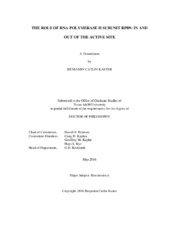| dc.description.abstract | Rpb9 is a conserved RNA polymerase II (pol II) subunit, the absence of which confers alterations to pol II enzymatic properties and transcription fidelity. It has been suggested previously that Rpb9 affects mobility of the trigger loop (TL), a structural element of Rpb1 that moves in and out of the active site with each elongation cycle. However, a biochemical mechanism for this effect has not been defined. We find that the mushroom toxin α-amanitin, which inhibits TL mobility, suppresses the effect of Rpb9 on NTP misincorporation consistent with a role for Rpb9 in this process. Furthermore, we have identified missense alleles of RPB9 in yeast that suppress the severe growth defect caused by rpb1-G730D, a substitution within Rpb1 α-helix 21. These alleles suggest a model in which Rpb9 indirectly affects TL mobility by anchoring the position of α21, with which the TL directly interacts during opening and closing. Amino acid substitutions in Rpb9 or Rpb1 that disrupt proposed anchoring interactions resulted in phenotypes shared by rpb9∆ strains, including increased elongation rate in vitro. Combinations of rpb9∆ with the fast rpb1 alleles that we identified did not result in significantly faster in vitro misincorporation rates than those resulting from the RPB1 mutations alone, and this epistasis is consistent with the idea that defects caused by the rpb1 alleles are related mechanistically to the defects caused by rpb9∆. We conclude that Rpb9 supports intra-pol II interactions that modulate TL function and thus pol II enzymatic properties, which distinguishes Rpb9 from its counterparts in pol I and III. In addition, we also find that several of the genetic interactions between RPB9 and genes encoding components of chromatin modifying complexes are dependent on the first 11-16 amino acids of the Rpb9 N-terminal domain. This same region also interacts with the transcription factor Bye1, and may be important for TFIIF association with pol II. This suggests that there are two distinct modes of Rpb9 function—one at the active site, and one on the exterior of pol II. | en |


